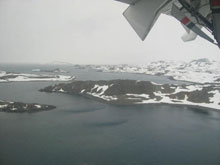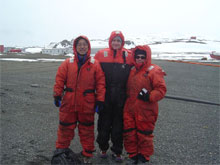The International contingent of researchers prepare to board the DHC-7 for King George Island. Click image for larger view and image credit.
King George Island, Antarctic
December 3, 2005
William Hanshumaker
Oregon State University
Public Marine Education Specialist
Extension Sea Grant Faculty
Though the Sounds of the Southern Ocean expedition was officially launched four days ago from Portland, Oregon, preparations began months before. Dr. Robert Dziak was notified in April that NOAA's Ocean Exploration program would help fund this pioneering research effort in Antarctica. Deploying an array of hydrophones (underwater microphones) to locate sounds from large whales, retreating ice sheets and undersea earthquakes has not been previously attempted in this harsh region. Proper organization and planning are always essential for any successful research venture, and especially in the extreme Antarctic environment.
Personnel and materials had to be assembled. The three hundred foot Russian icebreaker RV Yuzhmorgeologiya was secured to navigate these dangerous seas. Shipping containers with the hydrophones and other research equipment were sent from Oregon in mid-September. Dr. Dziak worked closely with Dr. Minkyu Park, of the Korea Polar Research Institute (KOPRI), to organize ship arrival and departure times, flight schedules, and hotel reservations. Last minute changes occurred up until the day of our departure.
Our first view of the King George Island, Antarctica, coastline. Click image for larger view and image credit.
It was rainy and 50 degrees F. when we left Portland on November 30th. We flew to Dallas, Texas, where we caught a connecting flight to Santiago, Chile. After clearing customs, we preceded by air to Punta Arenas, located near the southern tip of South America. We arrived at Punta Arenas late afternoon of Thursday, December 1st, requiring about 18 hours of flight time while traversing 5 time zones.
In many ways, Punta Arenas, Chile is similar to the Pacific Northwest. We recognized many of the plants, and were pleased to see them in bloom. It is nearing the end of spring here in the Southern Hemisphere. The lupine and Scotch broom are bright and vibrant. As we flew in over the coastline, I recognized rafts of cultivated oysters, identical to the ones we raise in the Pacific Northwest. The following day, we enjoyed fresh salmon for dinner. Salmon are also farmed in Chile, and researchers from the Hatfield Marine Science Center have traveled here in the past to assist with their cultivation.
Later that evening, we enjoyed a delicious dinner with twelve researchers from the KOPRI, who we joined for the last leg of our trip south to the Antarctic. The King Sejong Station is the Korean base on King George Island, where we will be spending our next two days before boarding the chartered Russian icebreaker. We also connected with Dr. Wang of the Institute of Geology and Geophysics, from the Chinese Academy in Beijing, who completed the international contingent of this expedition.
Haru Matsumote, Bob Dziak and Sara Heimlich in their Mustang suits, preparing to travel by small boat to the King Sejong Station. Click image for larger view and image credit.
Sounds of the Southern Ocean will be sending several reports from Dec 3 - 13. Please check back for additional logs from this expedition.
Sign up for the Ocean Explorer E-mail Update List.















